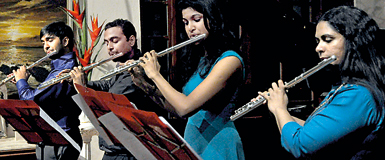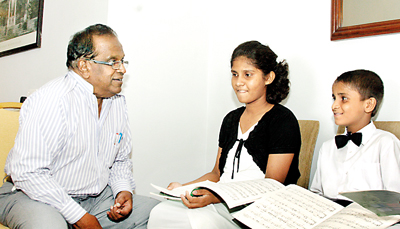Coming home
Descending the steps leading to the Cinnamon Grand garden terrace is someone who is clearly a visitor. Accompanied by two Sri Lankans who are showing her the way, the person (personage, rather), dressed in a close-fitting knee-length skirt, leather top, high heels and large sunglasses, shows curiosity about her surroundings. She spots a koka hopping across the tiled terrace and follows its dainty movements as it picks its way on black stick-like legs past a pond and disappears into lush foliage. The visitor is clearly charmed by the egret’s cute entrance, brief performance and neat exit. And spotless white-feather outfit.
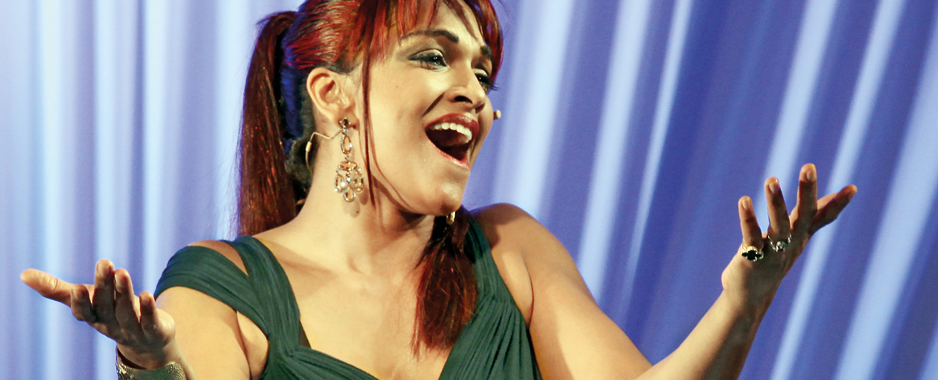
Emotional moment: Performing at the Cinnamon Grand on Wednesday. Photo: M. A. Pushpa Kumara
Come to think of it, the visitor, diva Danielle de Niese, is herself a master of entrances, performances and exits. In her case, the routine takes place on a stage, usually one of the world’s great opera or concert halls, and the entrances are dramatic, the performances ecstatic, the exits climactic, and the outfits terrific – just as they were the previous night, when diva de Niese performed in the Cinnamon Grand ballroom, before a wildly enthusiastic crowd of music lovers and distinguished persons.
Danielle de Niese’s Asian concert debut coincides with the 30-year-old opera star’s first visit to Sri Lanka – the tropical paradise that is her parents’ birthplace and ancestral homeland.
Danielle de Niese joins us at our table, apologising for being a few minutes late and flashing her familiar mischievous smile. With her are Mano Chanmugam and Neomal de Alwis, at whose invitation Danielle is visiting Sri Lanka. Mano and Neomal also presented last night’s concert. Like any event in which impresario extraordinaire Mano has had a hand, the evening was brilliant, sumptuous, and overflowing with warmth and generosity.
We are seated by the pond in front of the seafood restaurant. We have a few questions to ask the opera star.
“First, what are your thoughts about last night’s triumph, and being in Sri Lanka for the first time?”
“The show was incredible. It has been such a meaningful thing for me to come to Sri Lanka. I only know Sri Lanka through my parents. Everything I have heard about Sri Lanka came from them.
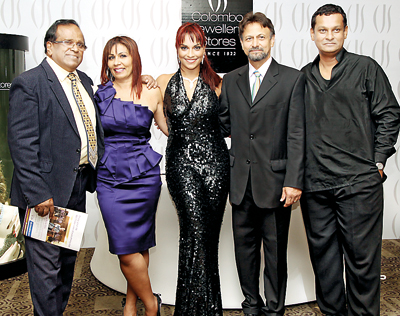
Afterglow: Danielle (centre) with her parents Beverly and Chris, and the men who made it happen - Mano Chanmugam (left) and Neomal de Alwis (right)
“When I got here, I said to Mano that I felt quite strange. I felt I was like in no-man’s land at first. And it was partly because my parents were not here yet. I was sad at lunch, I was sad at dinner. I didn’t feel I was really here until I met them. With them, I would have a contact for Sri Lanka.
“Part of that is because I was born in Australia. I had never visited Sri Lanka, and my only reference was through my parents’ stories and their upbringing, their childhood.
“So I was really pleased when they came, and to have them there sitting in the third row. I saw Mano, my husband, my mother, my father. It was very emotional for me. Like most of the concert, it was quite emotional.
“You know, it’s a long journey my parents have had. They left Sri Lanka when they were young. They met in Australia. I lived in Australia till I was only 10. And then we moved to America, to Los Angeles, and from Los Angeles to New Jersey.
“Three times they changed their whole lives, giving up everything each time. That’s a lot of sacrifice.
I was quite emotional thinking about that. And they, my Mom and Dad, have come full circle, all the way back to their beginnings, to bring this programme that we made specially for the Sri Lanka audience, and with the encores my Mum chose. It was very emotional.
“When you [turning to Mano] came up to me on the stage yesterday, and you said something I couldn’t quite catch, and then you said, ‘I can cry.’ And you were holding me, and your eyes were glassy. And it was like … I had been crying. Mum had been crying, Dad had been crying. Everyone was weeping!
“It’s a nice and a rare thing to have such an outpouring of emotion. I have definitely had emotions for my concerts, and people have been emotional about my concerts, but to have my immediate family there, and have everyone be so emotional. That was a very rare thing to have, and that makes it special.”
If the evening was special for Danielle and her family, it was overwhelming for the audience. In the crowd were members of the extended de Niese family, a family that has been associated with the arts, music in particular, in this country for at least four generations. Danielle de Niese’s great-grandfather George de Niese was both an outstanding artist and a musician. He was art master and choir master at St. Peter’s College, Bambalapitiya, for many years, and he wrote the school anthem.
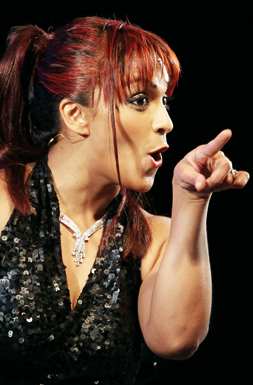
Danielle’s paternal grandparents, Douglas and Estelle de Niese, were well-known musicians in the ’50s and ’60s, and regular performers in choral music concerts and operetta. Danielle’s father was one of Douglas and Estelle’s 11 children. The family emigrated to Australia in 1972. Danielle’s mother Beverly Anderson is also a musician and, like Danielle’s father Christopher de Niese, was a child when her family migrated to Australia.
At the end of the concert, Danielle de Niese gestured to her parents and thanked them for making her the artist and celebrity she is.
Danielle subscribes more to the idea that outstanding people are the products of careful nurturing and their environment than they are beneficiaries of talents that run in the blood.
“Genes are a funny thing,” says Danielle. “I do believe a talent for music or art, whatever, can be inherited, passed down, but even if you are a child of a famously talented family, that does not guarantee you will become a star.
“I was lucky in the parents I have. Without Mom and Dad I would not be where I am. My parents, once they knew that they had a gifted child, dedicated their lives to nurturing me. They looked all over in Melbourne to find a singing teacher who would take on a student eight years old. Finally they found one. When I was 10, my parents gave up everything they had in Australia to take me to America. We settled in California, where I grew up.
I am a California girl. Then the family moved to New Jersey, to be close to good teachers and the classical music scene in New York. From the time I started lessons as a child of eight, my mother would be present in every music class I attended. She would sit in the room and listen closely and take notes. Then when we got home she would go over the music, note by note with me.
It was she who made me an artist. When others would simply sing a line straight, she would make me go over each word and note of the song and make me do more with it. If I did not have that close nurturing from my mother, I would have become just another singer. My father, though not a musician himself, was by my side all the time, looking for ways to further my music career, make me an artist. He would videotape every rehearsal I attended, and then at home he would play the video, and Mom and Dad and I would study those tapings and see how I could do even better. My parents are the closest beings in my life, and they have made me what I am.”
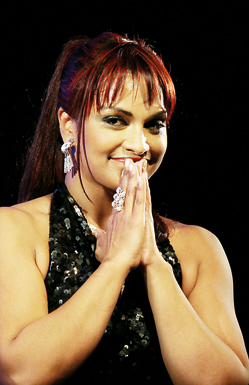
Magnetic presence: Danielle on stage. Photos: M. A. Pushpa Kumara
What Danielle de Niese is – a professional to the fingertips and beyond – we witnessed during rehearsals. We took a seat in a corner of the Cinnamon Grand bar, Sequel, and observed the diva, dressed in a flame-red summer frock, working on the Gershwin and Cole Porter songs with pianists Eshantha Peiris and Soundarie David. Every bar and note of the way she paused to instruct the pianists on how she wanted the music to go. “Everything has to be in proportion. …”, “Roll it, guys …”, “We don’t want to be in time there. …”, “Always be charming. …”, “That’s too busy. …”, “Can you play this like a romantic coda, nothing rhythmic? …”, “Enjoy these notes …”
She spent close on half an hour on a couple of bars of Gershwin’s “I Got Rhythm”, explaining meticulously the effects she wanted. When the bits were finally put together and the musicians ran through the song, de Niese belting out the words, “I got rhythm, I got music …”, you murmured to yourself: Boy, here’s a lady who is rhythm and music itself.
The atmosphere in the ballroom on the night of the concert was electric, as Danielle de Niese arrived through a door at the back and walked in semi-darkness down an aisle and up on to the stage. The face so familiar from photographs was smiling that mischievous child-like smile. The effect was ravishing. Once the music got started, de Niese matched facial expression and body language to words. The music seamlessly segued from Elizabethan to Baroque to Broadway. De Niese has a powerful stage presence, and Latin-Mediterranean looks that evoke the great divas of Italian opera and cinema.
We cannot let Danielle go without telling us what it feels like to be lady of the manor at famous Glyndebourne. When she married Gus Christie, heir to the world-famous opera house in Sussex, England, it was as if an opera fairytale had come alive.
“You are positioned in the opera world in a way that the other divas of this world would die for,” we say. To which de Niese instantly quips “or kill for!”
“Our courtship was very discreet, and after two years Gus proposed to me, in a little restaurant in Ohio on Valentine’s Day. And Glyndebourne is now home.”
Gus Christie was a wildlife photographer before he took on full responsibility for Glyndebourne, and was a regular visitor to Sri Lanka. Danielle and her parents Christopher and Beverly will be seeing Sri Lanka for the first time, and Gus Christie will be their travel guide.
“Gus knows a lot about Sri Lanka. In fact, this is what he gave me for my engagement ring – a Sri Lankan sapphire.”
Diva de Niese raises her hand to show a silver ring with a purple sparkle at its heart. Daniel de Neise has finally “come home.”
“I was quite emotional thinking about that. And they, my Mom and Dad, have come full circle, all the way back to their beginnings, to bring this programme that we made specially for the Sri Lanka audience, and with the encores my Mum chose. It was very emotional.
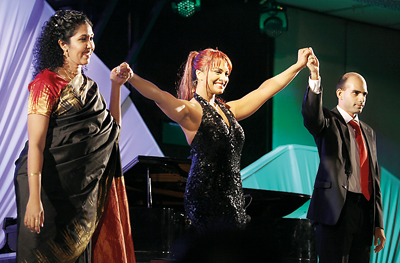
Close collaboration: Taking a bow with pianists Soundarie David and Eshantha Peiris.
“When you [turning to Mano Chanmugam] came up to me on the stage last night, you said something I couldn’t quite catch, and then you said, ‘I can cry.’ And you were holding me and your eyes were glassy. And it was like … I had been crying. Mum had been crying, Dad had been crying. Everyone was weeping!
“It’s a nice and a rare thing to have such an outpouring of emotion. I have definitely had emotions for my concerts, and people have been emotional about my concerts, but to have my immediate family there, and have everyone be so emotional. That was a very rare thing to have, and that makes it special.”
If the evening was special for Danielle and her family, it was overwhelming for the audience.
In the crowd were members of the extended de Niese family, a family that has been associated with the arts, music in particular, in this country for at least four generations. Danielle de Niese’s great-grandfather George de Niese was both an outstanding artist and a fine musician. He was art master and choir master at St. Peter’s College, Bambalapitiya for many years, and he wrote the school anthem. Danielle’s paternal grandparents, Douglas and Estelle de Niese, were well-known musicians in the ’50s and ’60s, and regular performers in choral music concerts and operetta. Danielle’s father was one of Douglas and Estelle’s 11 children. The family emigrated to Australia in 1972. Danielle’s mother Beverly Anderson is also a .musician and, like Danielle’s father Christopher de Niese, was a child when her family migrated to Australia.
At the end of last night’s concert, Danielle de Niese gestured to her parents and thanked them for making her the artist and celebrity she is.
Danielle subscribes more to the idea that outstanding people are the products of careful nurturing and their environment than they are beneficiaries of talents that run in the blood.
“Genes are a funny thing,” says Danielle. “I do believe a talent for music or art, whatever, can be inherited, passed down, but even if you are a child of a famously talented family, that does not guarantee you will become a star.
“I was lucky in the parents I have. Without Mom and Dad I would not be where I am. My parents, once they knew they had a gifted child, dedicated their lives to nurturing me. They looked all over in Melbourne to find a singing teacher who would take on a student eight years old. They found one. Then, when I was 10, my parents gave up everything they had in Australia to take me to America. We settled in California, where I grew up. I am a California girl. Then the family moved to New Jersey, to be close to good teachers and the classical music scene in New York.
“From the time I started singing lessons as a child of eight, my mother would be present at every music class I attended. She would sit in the room and listen closely and take notes. When we got home she would go over the music with me, note by note. It was she who made me an artist. When others would simply sing a line straight, she would make me go over each word and note and make me do something more with the song. If I did not have that close nurturing from my mother, I would have become just another singer.
“My father, though not a musician, was by my side all the time, looking for ways to further my career, make me an artist. He would videotape every rehearsal, and at home he would play the video, and Mom and Dad and I would study the tapings and see how I could do better. My parents are the closest beings in my life, and they have made me what I am.”
What Danielle de Niese is – a professional to the fingertips and beyond – we witnessed during rehearsals. We took a seat in a corner of the Cinnamon Grand bar, Sequel, and observed the diva, dressed in a flame-red summer frock, working on the Gershwin and Cole Porter songs with pianists Eshantha Peiris and Soundarie David. Every bar and note of the way she paused to instruct the pianists on how she wanted the music to go. “Everything has to be in proportion … roll it, guys … always be charming … that’s too busy … can you play this like a romantic coda? …enjoy these notes …”
She spent close on half an hour on a couple of bars of Gershwin’s “I Got Rhythm”, explaining meticulously the effects she wanted. When the bits were put together and the musicians ran through the song, de Niese belting out the words, “I got rhythm, I got music …”, we murmured: Man, this lady is rhythm and music itself.
The atmosphere in the ballroom on the night of the concert was electric, as Danielle de Niese arrived through a door at the back of the hall and walked in semi-darkness down the aisle, past the rows of music lovers and up on to the stage. The face familiar from photographs was smiling that radiantly winning smile.
The diva was beautiful beyond words. Once the music began, de Niese matched fluid facial expressions and rhythmic body language to words. Molto espressivo. The music segued from Elizabethan to Baroque to Broadway to popular arias. De Niese has a powerful stage presence, and her Latin-Mediterranean looks evoke the great divas of Italian opera and cinema.
Danielle insisted that she sent a thank-you kiss to the musicians who worked with her. At the concert, and again at this interview, she said the musicians – Lakshman Joseph de Saram and the Chamber Music Society of Colombo, pianists Eshantha Peiris and Soundarie David Rodrigo, and guitarist Jude Peiris – were “amazing.”
“These gifted young people had only two days of rehearsal, and they remembered every tiny instruction I gave them. When I sang Mozart’s Exultate Jubilate, I was exultant. They observed every detail I had pointed out. I cannot say how grateful I am to these fine young talents.”
We cannot let Danielle go without telling us what it feels like to be lady of the manor at Glyndebourne.
“You are positioned in the opera world in a way that other divas would die for,” we say. To which de Niese instantly quips, “Or kill for!”
When de Niese made her Glyndebourne debut as Cleopatra in Handel’s “Julius Caesar”, she became a celebrity overnight. She also caught the attention of Gus Christie, heir to the world-famous opera house in Sussex, England. After a discreet two-year courtship, Gus proposed.
“It was in a little restaurant in Ohio, on Valentine’s Day. And Glyndebourne is now home.”Marrying Gus Christie magically transformed Danielle’s life into a fairytale fantasy straight out of opera.
From then on it has been one steady ascent in the music and social worlds. The Christies move with royalty. Danielle has been a guest at Buckingham Palace, been photographed with Prince Charles and Camilla, and is a friend of Michelle Obama’s. At 30, the diva has gone as far and as high as it seems possible to go in society, and now she has only to focus on her career. Even fairytales don’t get that good.
Gus Christie was a wildlife photographer before he took on full responsibility for Glyndebourne, and has been a regular visitor to Sri Lanka. Danielle and her parents will be seeing the country with Gus as their travel guide.
“Gus knows a lot about Sri Lanka. In fact, this is what he gave me for my engagement ring – a Sri Lankan sapphire.” Diva de Niese raises her hand to show a silver ring with a purple stone. The Christies and the de Nieses leave the next day on a sightseeing tour of Dambulla, Nuwara Eliya and Galle, where Danielle will give her second concert, on Wednesday, November 25.
On the matter of miscegenation, Danielle is proud of her rich ancestry, which contains Dutch, Portuguese, Scottish and Sri Lankan elements, but will not say whether she should attribute her gifts to all that exotically mixed blood. What she does point out is that she embraces several hemispheres, having been born in Australia, grown up in America, studied languages in Europe, and now was in the act of discovering Asia. “I am looking forward to seeing Sri Lanka and absorbing the culture of my parents’ birthplace,” she says.
A passing thought. Has Danielle ever had her horoscope read? “This is a very Sri Lankan thing to do, to have a reading done,” we tell the diva. “Your horoscope would make interesting reading, for sure. All Buddhist and Hindu families have a horoscope cast when a child is born. Only the parents are privy to the contents of their child’s horoscope.”
“Oh, my parents would love that!” laughs Danielle. “Once, at a funfair when I was a child, an American Indian palmist saw me and insisted on looking at my palm. He said the deep lines were unusual for a child. You have been here many times, he said, referring to reincarnation. And I think that there may be some truth there. I have been told that as a child I was unusually quick to learn and wise beyond my years. I began to realise that myself, noticing that I was in many ways ahead of others my age. So I will be open to that mystical side of things.”
Follow @timesonlinelk
comments powered by Disqus



















